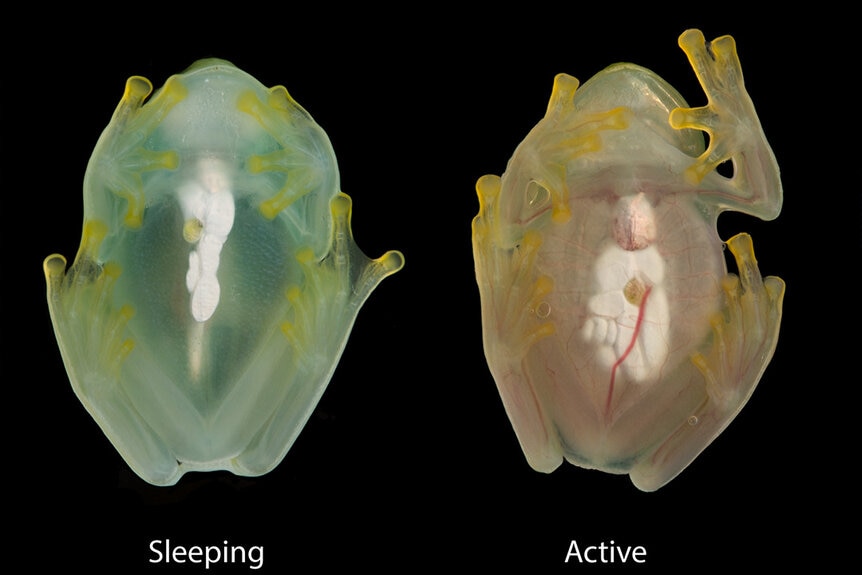Create a free profile to get unlimited access to exclusive videos, sweepstakes, and more!
Glass frogs become invisible by holding their breath and hiding their blood
It's a disgusting game of peekaboo, but it works.

It’s tough being a frog. You have to account for opposing lanes of traffic across a busy highway and, if you get through that, you have to hop across logs and the backs of turtles, avoiding alligators, just trying to get home. That’s the life of a frog, at least according to the beloved and long-lived arcade game Frogger. We’re used to controlling the frog with a joystick, but now, for the first time, people can be the frog in a Peacock original gameshow of the same name!
Real life frogs might not have to contend with cars, logs, and gators every time they want to go somewhere, but they have their own challenges. Mostly those challenges are finding enough to eat while avoiding being eaten yourself. As Kermit famously said, it’s not easy being green. Maybe that’s why the glass frog decided they’d be clear instead.
Transparency isn’t the most novel thing in the animal kingdom. Plenty of animals do it for a variety of reasons and through a variety of mechanisms. The icefish, a bizarre transparent fish from the Antarctic, achieves a high level of transparency because it doesn’t have any hemoglobin in its blood. The oxygen is fully dissolved in the plasma, which is transparent, and doesn’t need anything to transport it. Vertebrates, like people and frogs, are sadly stuck with the blood we’ve got, hemoglobin and all, which means that a transparent frog is a special thing.
RELATED: As amphibians die out, human disease rises
Scientists suspected that the glass frogs were hiding their red blood cells somewhere when they want to go stealth mode, but figuring out what they were doing and how they were doing it was a challenge. That’s because glass frogs are really picky about when they go transparent. Now, a new study published in the journal Science has solved the mystery, thanks to a new imaging technique.
“They only become transparent when they feel they are absolutely safe. If you put them to sleep through sedation, they do not store the red blood cells. They keep them in the circulatory system because it’s not a native or normal condition for the frog. You can’t touch them, you can’t sedate them, and you can’t inject anything. It makes them very hard to study,” Junjie Yao, a researcher from the Department of Biomedical Engineering at Duke University and one of the paper’s authors, told SYFY WIRE.
Scientists needed a way to probe inside the frogs’ bodies without disturbing them. While one research team was searching for a way to peer inside their frogs, another team had developed a new imaging system using soundwaves and needed a test case. It was the perfect marriage.
“We developed this imaging system; it’s called photoacoustic imaging and it’s a technology that can track the red blood cells without waking up the frogs. We scanned the whole body while they were sleeping and found it was the liver that had all the red blood cells,” Yao said.
The images revealed that when the frogs are active during the night, they let their red blood cells loose and they circulate throughout the body transporting oxygen, same as they do in your body. As a result, the tissues are filled with blood and take on a reddish hue. When they’re ready to call it a day, however, they need a place to rest that’s safe from birds. So, they tuck themselves on the underside of a leaf.
That would be good enough except that glass frogs are nocturnal and sleep during the day. Their little frog bodies make perfect shadows through the underside of the leaf. That’s when they kick on their cloaking shields. They pull about 90% of their red blood cells into the liver and increase their transparency by roughly threefold.
“They sleep underneath a piece of leaf, upside down and belly up. They are very transparent, and you can see all the way through to the back skin, which is green colored. When they are upside down under a piece of green leaf the birds can’t see them,” Yao said.
RELATED: Brains or beauty? Frogs choose intelligence or camouflage to evade predators
All at once, the frogs can’t be seen, but they also can’t transport oxygen and they don’t have any of that sweet Antarctic plasma blood the icefish are rocking. According to Yao, less than 1% of ordinary oxygen levels are available during these transparency periods and that oxygen has to support all of the frog’s biological functions for a 10-hour stretch while they sleep.
“Because of the large concentration of red blood cells in the liver, it has to expand about 30% in volume. For humans, that could be deadly because the red blood cells are so concentrated it could trigger a clotting reaction,” Yao said.
Glass frogs don’t have that problem. They tuck their red blood cells away every day and then release them within seconds once they wake, with no problems. Researchers are now interested in figuring out how they do that. Such an efficient and reliable anticlotting system could be a medical game changer. It’s unlikely that we’ll be able to use the glass frog’s transparency trick for ourselves, we just aren’t built the same, but not dying of a blood clot is a pretty good consolation prize.
Watch one person after another wish they could turn invisible after falling on their faces on the Frogger course. Frogger is streaming right now on Peacock!



























